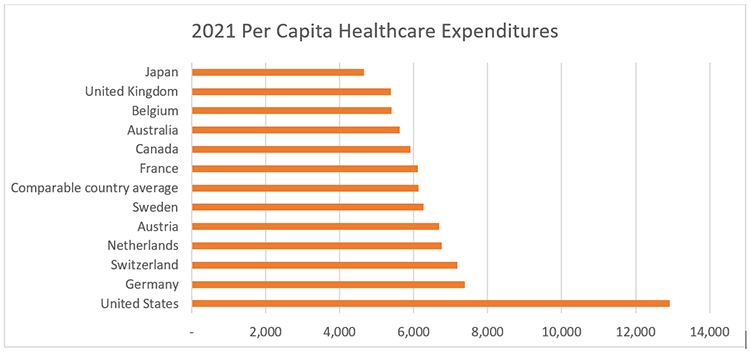Where Do Our Healthcare Dollars Go?

The United States spends twice as much per person on health compared to other developed nations.1
Where is this excess money being spent? Are health care outcomes that much better in the U.S. versus the rest of the world?
Let’s examine some data:

Source: KFF analysis of National Health Expenditure (NHE) and OECD data.
All countries in the previous chart, except the U.S., guarantee universal health coverage to all residents. In addition to public coverage, people in some of these countries have the option to purchase additional private coverage. In France, essentially the entire population has both private and public insurance.
The U.S. is the only developed country where a significant number of people lack any form of health insurance. In 2021, 8.6% of the U.S. population was uninsured.2
Why do Americans pay so much more than other developed nations? It turns out that there are several factors at play: insurance and provider administrative costs are the biggest component of excess U.S. spending, followed by higher prices paid for prescription drugs and higher physician pay.
| Component | Share of excess spending |
|---|---|
| U.S. pays more in administrative costs of insurance | ~15% |
| U.S. providers spend more on administrative activities | ~15% |
| U.S. pays more for prescription drugs | ~10% |
| U.S. physicians earn more | ~10% |
| U.S. registered nurses earn more | ~5% |
| U.S. invests more in medical machinery and equipment | <5% |
| Sum of components estimated | ~60% |
Source: Ani Turner, George Miller, and Elise Lowry, High U.S. Health Care Spending: Where Is It All Going? (Commonwealth Fund, Oct. 2023). https://doi.org/10.26099/r6j5-6e66
If the U.S. is spending so much on healthcare, we should be the healthiest nation, right? Unfortunately this is not the case.
The picture is much different than one would expect. Americans see doctors less often than most folks in the developed world. In fact, the U.S. has one of the lowest rates of practicing physicians and hospital beds per 1,000 population in the developed world. American babies also have the lowest life expectancy at birth, and U.S. infant and maternal death rates are the highest in the developed world. The U.S. obesity rate is almost twice the OECD average, and our country has the highest death rates for avoidable and/or treatable conditions. Sadly, the U.S. also has one of the highest suicide rates.3
Cost is the primary reason why many Americans do not sign up for health insurance. Also, out-of-pocket costs lead almost half of working-age adults to skip or delay getting needed care.4
But wait, it’s not all bad!
The United States spends more on healthcare per person than any other country but comes in dead last in many health outcomes. Not good, indeed.
But… and this is important: The American healthcare system produces more medical research and pharmaceutical development. These advances have led to groundbreaking discoveries and improved treatments.5 In fact, the United States leads the world in new drug and medical devices, has the highest number of Nobel laureates in chemistry and medicine, and produces the second-highest number of scientific works in the world.6
So where do we go from here?
It’s complicated! Would we give up leading-edge healthcare innovations and new cures for diseases if we adopted Medicare for All? Morally, should healthcare be a profitable enterprise at all? Would it in fact be cheaper if the government ran the healthcare system, as it already does for those over 65?
Lots of questions, few simple answers…
Since 1965, Americans 65 and older and folks living in poverty have had universal healthcare in the form of Medicare and Medicaid. The global trend has been moving towards universal healthcare for decades. What the future brings for Americans is anyone’s guess. That said, I suspect that, for better or for worse, universal healthcare will be a reality in the U.S. before I cross the finish line in this world.
In the meantime, proper planning for healthcare costs in retirement is paramount. Drop me a line if you would like to discuss.
Read the February 2024 Financial Planning Focus:
- "Investing at All-Time Highs" By Ryan Streilein, CFA »
- "To Rent or to Buy?" By Victoria Henry, CFP® »
- "Take Advantage of New IRS Rules" by Laurie Kramer, CFP® »
1Munira Z. Gunja, Evan D. Gumas, and Reginald D. Williams II, U.S. Health Care from a Global Perspective, 2022: Accelerating Spending, Worsening Outcomes (Commonwealth Fund, Jan. 2023). https://www.commonwealthfund.org/publications/issue-briefs/2023/jan/us-health-care-global-perspective-2022
2Amy E. Cha and Robin A. Cohen, “Demographic Variation in Health Insurance Coverage: United States, 2021,” National Health Statistics Report, no. 177 (Centers for Disease Control and Prevention, U.S. Department of Health and Human Services, Nov 3, 2022).
4Sara R. Collins, Lauren A. Haynes, and Relebohile Masitha, The State of U.S. Health Insurance in 2022: Findings from the Commonwealth Fund Biennial Health Insurance Survey (Commonwealth Fund, Sept. 2022); and Michelle M. Doty et al., “Income-Related Inequality in Affordability and Access to Primary Care in Eleven High-Income Countries,” Health Affairs 40, no. 1 (Jan. 2021): 113–20.
52. US public investment in development of mRNA covid-19 vaccines: retrospective cohort study. Lalani HS, Nagar S, Sarpatwari A, et al. BMJ. 2023;380:0. [PMC free article] [PubMed] [Google Scholar]
63. United States: #6 in the 2021 world index of healthcare innovation. [ May; 2023 ]. 2021. https://freopp.org/united-states-freopp-world-index-of-healthcare-innovation-72256925520f
IMPORTANT DISCLOSURES
West Financial Services, Inc. (“WFS”) offers investment advisory services and is registered with the U.S. Securities and Exchange Commission (“SEC”). SEC registration does not constitute an endorsement of the firm by the SEC nor does it indicate that the firm has attained a particular level of skill or ability. You should carefully read and review all information provided by WFS, including Form ADV Part 1A, Part 2A brochure and all supplements, and Form CRS.
Certain information contained herein was derived from third party sources, as indicated, and has not been independently verified. While the information presented herein is believed to be reliable, no representation or warranty is made concerning the accuracy of any information presented. Where such sources include opinions and projections, such opinions and projections should be ascribed only to the applicable third party source and not to WFS
This information is intended to be educational in nature, and not as a recommendation of any particular strategy, approach, product, security, or concept. These materials are not intended as any form of substitute for individualized investment advice. The discussion is general in nature, and therefore not intended to recommend or endorse any asset class, security, or technical aspect of any security for the purpose of allowing a reader to use the approach on their own. You should not treat these materials as advice in relation to legal, taxation, or investment matters. Before participating in any investment program or making any investment, clients as well as all other readers are encouraged to consult with their own professional advisers, including investment advisers and tax advisers.

